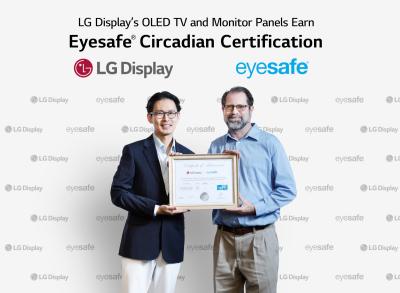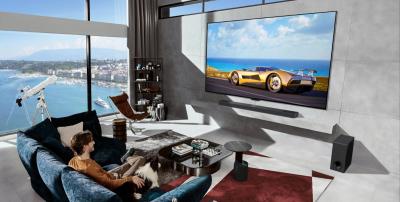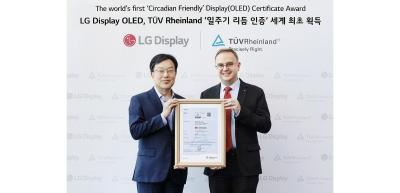Blue light hazard and OLED displays
In recent years, exposure to a too much blue light, especially towards the night, has been linked to many health issues - including cancer, diabetes, heart disease, obesity and insomnia. It is believed that blue light suppresses the body's melatonin secretion (which helps the body regulates its sleep) as natural light shifts into a different spectrum towards the night.
OLED displays emit far less blue light compared to LCDs - as OLEDs are emissive and do not rely on a white light source. In addition researchers have developed bluelight-free OLED lighting panels (also called candle-light OLEDs). We hope that more research results will help clarify the exact effects of displays on our bodies and perhaps help the industry develop safer displays.
LG Display's WOLED panels receive Eyesafe's Circadian Certification
LG Display announced that its entire lineup of OLED TV and monitor panels, from 27 to 97 inches (all of its WOLED panels), have become the world’s first displays to receive Eyesafe Circadian Certification. LG Display’s OLED TV and monitor panels achieved the highest circadian certification rating (CPF 50).
EyeSafe, a US-based company specializing in blue light mitigation solutions, says that LG's OLED panels are promoting eye health and better sleep, as the emit just 36% blue light, the lowest in the industry.
Study reveals OLED TVs promote healthier sleep patterns compared to LCD screens
Seoul's Kookmin University researchers concluded a clinical study to verify the impact of TV panels of sleep, measuring the levels of the sleep-inducing hormone melatonin in 40 adult men and women divided into groups watching the same content on either LCD or LG's WOLED TVs.
The researcher found that melatonin secretion fell 2.7% over two hours for the LCD group and it increased 8.1% in the OLED TV group. Melatonin rises in the evening to prepare the body for sleep, but the blue light emitted from displays disturbs the melatonin secretion as it confuses the body. As LCDs emit about twice as much blue light as OLEDs, it is not a surprise they have this effect on melatonin levels.
LGD's 3rd-gen META OLED TV panels earned UL Solution's platinum eye safety rating
LG Display announced that its third-generation WOLED META TV panels have earned UL Solutions' Platinum eye safety rating and the UL Mark for low blue light. LGD's panels earned a score of 36%, the lowest among all existing TV panels (conventional LCDs range from 70-80%, and lower scores are better).
This year, UL Solutions has implemented more stringent criteria for measuring blue light emissions in an effort to give consumers more reliable information, with program ratings now classified as Platinum, Gold, Silver, and Bronze. The top rating, Platinum, is awarded to display products with blue light wavelength emissions that sit below 40% of the total blue light wavelength emissions.
UDC discusses its RGBB display architecture and its advantages in color reproduction and color gamut
During iMID 2023, Universal Display discussed the company's RGBB display architecture, highlighting the advantages regarding color gamut and color reproduction.The RGBB architecture basically adds a fourth OLED subpixel, a light-blue (or cyan) one to a standard RGB deep-color stack.
The current approach to achieve a large color gamut (UDC targets BT.2020) is to use emitters with a narrow spectrum, which enables high color gamut. But there's a catch - each person has a different color perception, and some people are less sensitive to certain colors compared to the "average observer". This causes a display that is based on narrow-spectrum emitters to suffer from distorted perceived colors.
LG's OLED TV and monitor panels are the first to earn the Circadian-Friendly certification from TÜV Rheinland
Independent testing and certification leader TÜV Rheinland has awarded LG's OLED TV and monitor panels with its 'Circadian Friendly' certification. LG's OLEDs are the first displays to ever receive this award.
TÜV Rheinland new 'Circadian Friendly' certification is given to products that meet the standards of minimizing their impact on people's quality of life during the day and promote better sleep at night. These products undergo rigorous testing based on the 'Circadian Stimulus' metric, designed by the Rensselaer Polytechnic Institute's Lighting Research Center.
Samsung introduces new low-blue-light AMOLED displays
Samsung has demonstrated new AMOLED display panels that offer a lower blue-light emission compared to its current low-blue-light AMOLEDs. Samsung says that the new display reduces blue light emission by 70% compared to 'conventional' displays (which probably means LCD displays, not standard AMOLEDs).
Samsung brands these new displays as Gen-2 LBL (low-blue-light) AMOLEDs, and says that the lower blue light emission was achieved by a combination of the latest OLED emitter materials and advanced AI software. Samsung is mostly targeting laptop displays, saying that the new Gen-2 LBL displays can achieve a brightness of up to 2,000 nits. Samsung will start producing Gen-2 LBL AMOLEDs by the end of 2023.
LG Display and EyeSafe release a blue-light whitepaper
Blue light management expert Eyesafe, together with LG Display, published a white paper that examines the major display technologies for television, including LCD and OLED, and their potential influence on eye health and circadian rhythm. Exposure to blue light affects sleep cycles by suppressing levels of melatonin in the brain.

One of the benefits of OLED TV is its naturally low blue light emissions as compared to those of traditional LCD TVs on the market. "Even while maintaining perfect black and high contrast characteristics with excellent picture quality, OLED provides the user with better eye comfort and viewing experience".
NTHU develops an efficient and long lasting bluelight-free tandem OLED device
Taiwan's National Tsing-Hua University (NTHU) Professor Jou and Dr. Wen have been developing OLED lighting technologies for many years, focusing on healthy bluelight-free OLEDs (so-called candle-light OLEDs) due to the hazards of modern lighting.
The researchers now report they have developed a new tandem-OLED device that improves the efficiency and lifetime of their candle-light OLEDs. The OLED's emission is totally blue-light free, which makes it even safer compared to NTHU's first-gen candle-light OLEDs.
NTHU installs over 200 OLED candle-light lamps at Taiwan's Smangus tribe
Taiwan's National Tsing-Hua University (NTHU) Professor Jou has been researching the hazards of blue light for many years, warning us against the hazards of modern lighting and focusing on OLED lighting as the technology that enables low blue-light emission lighting. In 2015, NTHU started to develop its low blue-light candle-light orange-type OLED technology, initially in collaboration with Wisechip and later with China-based OLED lighting producer First-o-lite.
NTHU has been promoting these candle-light OLEDs for the Smangus tribe in Taiwan's Jianshi Township which has been avoiding artificial light pollution. NTHU and the tribe managed to raise money to produce 240 OLED lamps, 90 for street lights and the rest to light up more than 100 cabins in the tribe's village. This is a beautiful project and hopefully will bring more attention to the hazards of blue light and the advantages of OLED lighting technologies.
NTHU and First-o-lite Candle-light OLED lamp - hands on review
NTHU professor Jou has been researching the hazards of blue light for many years, warning us against the hazards of modern lighting and focusing on OLED lighting as the technology that enables low blue-light emission lighting.
In 2015, NTHU started to develop its low blue-light candle-light orange-type OLED technology, initially in collaboration with Wisechip and later with China-based OLED lighting producer First-o-lite.
Pagination
- Page 1
- Next page







